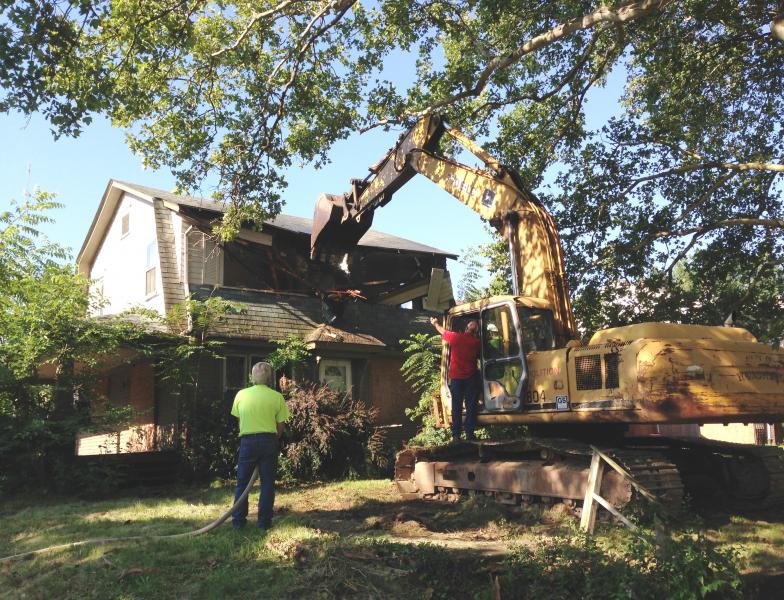Looking like the claw of some prehistoric predator, an excavator’s massive scoop and arm slashes down on a house in the Taft School neighborhood on Youngstown’s south side.
 Bob Gray lives down the street. Bob Gray lives down the street.
“Boy, it takes a few days to build ‘em -- but one day and its down.And look at all that old oak. It’s all oak construction”
Just the beginning
The tear-down is the first of what will be dozens in a joint effort of the city of Youngstown and the Air Force Reserve Station at Vienna to remove abandoned buildings in the city.
Base commander, Col. James Dignan says, “There are a lot of Air Force Community Partnership programs out there, but not quite like this one. “There are a lot of Air Force Community Partnership programs out there, but not quite like this one.
The 910th is a civil engineering squadron. Demolition and construction are among its main missions. So the Youngstown project is perfect for helping the unit prepare.
“We’ll get some of our folks trained for their wartime requirements, and we get to do it right here in our own back yard.”
3,999 to go
John Swierz is watching from the street with Col. Dignan; the house is already half gone.
He’s the city councilman for this ward, the 7th.
“We have 4,000 homes in the city that need demolished.
"So, every bit that we can get from the Air Force Reserve base is going to help us especially in neighborhoods like this -- around a public school. And a lot of the kids that go to that school walk. And these kind of vacant houses present many, many challenges. You don’t know if there are vagrants in ‘em. You don’t know if there’s dope in there."
Boots on the ground
The colonel says the joint project also puts some reality, and a sense of purpose in his unit's training.
“This is the start to the road to recovery. And cleaning up these neighborhoods and taking down these eyesores that, talking to a couple of the local residents, started having problems. I guess this one had an attempted arson. And that’s what kind of brought it to get this one taken down now.”
Ten houses in the immediate area are slated for demolition too. Neighbor Bob Gray says the need to be.
“The school bus stops here and picks up kids. And for other schools, too. And we were concerned; God forbid some kid gets dragged into one of these houses and something happens. And the mayor totally agreed and he was planning on getting this one down.”
The pressure to shrink
John Swierz says, back in the day, there never would have been fear like that in this neighborhood. But that was then, before steel collapsed and huge numbers of city residents who were invested in the community left to find work.
“In the 1960s, and 70s, we were the No. 1 city in the country on home ownership per-capita. It was about 74 percent. Today we’re looking at probably 51/50 rental."
Bittersweet
Col. Dignan looks around at the other abandoned houses that will soon face the excavator and back to the one it has no all but obliterated, and notes
 that many were tidy craftsman-style bungalows before the blight took over. that many were tidy craftsman-style bungalows before the blight took over.
“It’s a little bittersweet. It’s nice to the city and the airbase come together to partner like this. But on the other hand, it’s a shame to see what was obviously a nice family home come down.”
There is an important economic component to the blight tear-down too.
In its now nationally famous “comprehensive plan” called Youngstown 2010, the city formally set about shrinking itself physically. In 1960, it had a population of 160,000 -- and housing for a community that size.
By the time Youngstown 2010 was drawn up, the population was 70,000, It’s just 65,000 now. But the housing remained.
There is no way for the city to pay for services for all of that. Thus the demolition program -- and another reason why the air reservists are more than welcome to hone their building-crashing skills in Youngstown. |